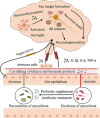Interplay between microglia and environmental risk factors in Alzheimer's disease
- PMID: 38103237
- PMCID: PMC10960290
- DOI: 10.4103/1673-5374.389745
Interplay between microglia and environmental risk factors in Alzheimer's disease
Abstract
Alzheimer's disease, among the most common neurodegenerative disorders, is characterized by progressive cognitive impairment. At present, the Alzheimer's disease main risk remains genetic risks, but major environmental factors are increasingly shown to impact Alzheimer's disease development and progression. Microglia, the most important brain immune cells, play a central role in Alzheimer's disease pathogenesis and are considered environmental and lifestyle "sensors." Factors like environmental pollution and modern lifestyles (e.g., chronic stress, poor dietary habits, sleep, and circadian rhythm disorders) can cause neuroinflammatory responses that lead to cognitive impairment via microglial functioning and phenotypic regulation. However, the specific mechanisms underlying interactions among these factors and microglia in Alzheimer's disease are unclear. Herein, we: discuss the biological effects of air pollution, chronic stress, gut microbiota, sleep patterns, physical exercise, cigarette smoking, and caffeine consumption on microglia; consider how unhealthy lifestyle factors influence individual susceptibility to Alzheimer's disease; and present the neuroprotective effects of a healthy lifestyle. Toward intervening and controlling these environmental risk factors at an early Alzheimer's disease stage, understanding the role of microglia in Alzheimer's disease development, and targeting strategies to target microglia, could be essential to future Alzheimer's disease treatments.
Copyright © 2024 Copyright: © 2024 Neural Regeneration Research.
Conflict of interest statement
Figures



Similar articles
-
Microglia, Lifestyle Stress, and Neurodegeneration.Immunity. 2020 Feb 18;52(2):222-240. doi: 10.1016/j.immuni.2019.12.003. Epub 2020 Jan 7. Immunity. 2020. PMID: 31924476 Free PMC article. Review.
-
Distinct microglial response against Alzheimer's amyloid and tau pathologies characterized by P2Y12 receptor.Brain Commun. 2021 Jan 29;3(1):fcab011. doi: 10.1093/braincomms/fcab011. eCollection 2021. Brain Commun. 2021. PMID: 33644757 Free PMC article.
-
Gut Microbiota as a Link between Modern Lifestyle and Alzheimer's Disease.Curr Aging Sci. 2021;14(3):164-180. doi: 10.2174/1874609814666210609100048. Curr Aging Sci. 2021. PMID: 34151770 Review.
-
Fibrillar Aβ triggers microglial proteome alterations and dysfunction in Alzheimer mouse models.Elife. 2020 Jun 8;9:e54083. doi: 10.7554/eLife.54083. Elife. 2020. PMID: 32510331 Free PMC article.
-
Microglia Gone Rogue: Impacts on Psychiatric Disorders across the Lifespan.Front Mol Neurosci. 2018 Jan 4;10:421. doi: 10.3389/fnmol.2017.00421. eCollection 2017. Front Mol Neurosci. 2018. PMID: 29354029 Free PMC article. Review.
Cited by
-
Potential role of tanycyte-derived neurogenesis in Alzheimer's disease.Neural Regen Res. 2025 Jun 1;20(6):1599-1612. doi: 10.4103/NRR.NRR-D-23-01865. Epub 2024 Jun 26. Neural Regen Res. 2025. PMID: 38934388 Free PMC article.
-
Cerebellar microglia: On the edge between neuroinflammation and neuroregulation.Neural Regen Res. 2026 Jan 1;21(1):156-172. doi: 10.4103/NRR.NRR-D-24-00550. Epub 2024 Oct 22. Neural Regen Res. 2026. PMID: 40489344 Free PMC article.
-
Trajectory of brain-derived amyloid beta in Alzheimer's disease: where is it coming from and where is it going?Transl Neurodegener. 2024 Aug 19;13(1):42. doi: 10.1186/s40035-024-00434-9. Transl Neurodegener. 2024. PMID: 39160618 Free PMC article. Review.
-
Association between ethylene oxide exposure and osteoarthritis risk mediated by oxidative stress: evidence from NHANES 2013-2020.Med Gas Res. 2025 Jun 1;15(2):348-355. doi: 10.4103/mgr.MEDGASRES-D-24-00054. Epub 2024 Nov 8. Med Gas Res. 2025. PMID: 39511755 Free PMC article.
-
Glycolytic dysregulation in Alzheimer's disease: unveiling new avenues for understanding pathogenesis and improving therapy.Neural Regen Res. 2025 Aug 1;20(8):2264-2278. doi: 10.4103/NRR.NRR-D-24-00190. Epub 2024 Jul 29. Neural Regen Res. 2025. PMID: 39101629 Free PMC article.
References
-
- Abraham D, Feher J, Scuderi GL, Szabo D, Dobolyi A, Cservenak M, Juhasz J, Ligeti B, Pongor S, Gomez-Cabrera MC, Vina J, Higuchi M, Suzuki K, Boldogh I, Radak Z. Exercise and probiotics attenuate the development of Alzheimer's disease in transgenic mice: Role of microbiome. Exp Gerontol. 2019;115:122–131. - PubMed
LinkOut - more resources
Full Text Sources

